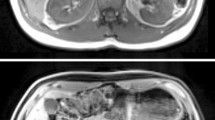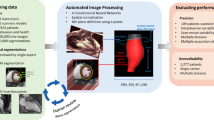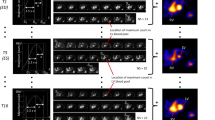Abstract
A completely operator-independent boundary detection algorithm for multigated blood pool (MGBP) studies has been evaluated at four medical centers. The knowledge-based boundary detector (KBBD) algorithm is nondeterministic, utilizing a priori domain knowledge in the form of rule sets for the localization of cardiac chambers and image features, providing a case-by-case method for the identification and boundary definition of the left ventricle (LV). The nondeterministic algorithm employs multiple processing pathways, where KBBD rules have been designed for conventional (CONV) imaging geometries (nominal 45° LAO, nonzoom) as well as for highly zoomed and/or caudally tilted (ZOOM) studies. The resultant ejection fractions (LVEF) from the KBBD program have been compared with the standard LVEF calculations in 253 total cases in four institutions, 157 utilizing CONV geometry and 96 utilizing ZOOM geometries. The criteria for success was a KBBD boundary adequately defined over the LV as judged by an experienced observer, and the correlation of KBBD LVEFs to the standard calculation of LVEFs for the institution. The overall success rate for all institutions combined was 99.2%, with an overall correlation coefficient ofr=0.95 (P<0.001). The individual success rates and EF correlations (r), for CONY and ZOOM geometers were: 98%,r=0.93 (CONV) and 100%,r=0.95 (ZOOM). The KBBD algorithm can be adapted to varying clinical situations, employing automatic processing using artificial intelligence, with performance close to that of a human operator.
Similar content being viewed by others
References
Chang W, Henkin RE, Hale DJ, et al. Methods for detection of left ventricular edges.Semin Nucl Med 1980; 10: 39–53.
Jackson PC, Allen-Naker R, Rhys Davies E, Rees Russel J, Wilde R, Watt I. The assessment of an edge detection algorithm in determining left ventricular ejection fraction using radio-nuclide multiple gated acquisition and contrast ventriculography.Eur J Nucl Med 1982; 7: 62–65.
Cahill PT, Ornstein E, Ho SL. Edge detection algorithms in nuclear medicine.IEEE Trans Nucl Sci 1976; 23: 555–559.
Jackson PC, Wilde R, Watt I, Rhys Davies J. An edge detection algorithm for use in radionuclide imaging.Eur J Nucl Med 1981; 6: 33–38.
Hawman EG, Turner DA, Erwin WD, Lee PC, Groch MW. A new edge enhancement operator and its application to the analysis of gated cardiac scintigrams.J Nucl Med 1981; 22: 53.
Smith MC.Error and variation in diagnostic radiology, Thomas, Springfield, Ill., 1967.
Seals AA, Verani MS, Tadros S, et al. Comparison of left ventricular diastolic function as determined by nuclear cardiac probe, radionuclide angiography, and contrast cineangiography.J Nucl Med 1986; 27: 1908–1915.
Spodick DH. On experts and expertise: the effect of variability in observer performance.Am J Cardiol 1975; 36: 529.
Cooper JA. Use of simulated annealing for finding left ventricular regions of interest in gated blood pool studies.J Nucl Med 1992; 33: 923P.
Hoffmann KR, Chen CT, Doi K. Automated region identification and its application to measuring cardiac function.Am J Card Imag 1991; 5: 272–280.
Qian J, DeVito RP, Groch MW, et al. Knowledge-based LV detection and automatic EF calculation for gated blood pool studies.J Nucl Med 1992; 33: 932P.
Groch MW, Erwin WD, Qian J, et al. Clinical verification of a knowledge-based boundary detector: a multicenter study.J Nucl Med 1992; 33: 938P.
Qian J, Khair MM. Knowledge-based topographic feature extraction in medical images.Proc SPIE 1995; 2622: 871–878.
Wagner RH, Halama JR, Henkin RE, et al. Errors in the determination of left ventricular functional parameters.J Nucl Med 1989;30:1870–1874.
Corbett JR, Jansen DE, Lewis SE, et al. Tomographic gated blood pool radionuclide ventriculography analysis of wall motion and left ventricular volumes in patients with coronary artery disease.J Am Coll Cardiol 1985; 6: 349–358.
Gill JB, Moore RH, Tamaki N, et al. Multigated blood-pool tomography: new method for the assessment of left ventricular function.J Nucl Med 1986; 27: 1916–1924.
Fischman AJ, Moore RH, Gill JB, Strauss HW. Gated blood pool tomography: a technology whose time has come.Semin Nucl Med 1989; 19: 13–21.
Faber TL, Stokely EM, Templeton GH, et al. Quantification of three-dimensional left ventricular segmental wall motion and volumes from gated tomographic radionuclide ventriculograms.J Nucl Med 1989; 30: 638–649.
Groch MW, Liedholdt EM, Marshall RA, et al. Gated blood pool SPECT imaging: sources of artifacts.Clin Nucl Med 1991;16:717.
Groch MW, Marshall RC, Erwin WD, Schippers DJ. Quantitative gated blood pool SPECT imaging: enhanced sensitivity for non-invasive assessment of coronary artery disease.J Nucl Med 1993; 34: 35P.
Author information
Authors and Affiliations
Additional information
This material was presented, in part, at the 39th annual meeting of the Society of Nuclear Medicine, Toronto, Canada.
Rights and permissions
About this article
Cite this article
Groch, M.W., Erwin, W.D., Murphy, P.H. et al. Validation of a knowledge-based boundary detection algorithm: a multicenter study. Eur J Nucl Med 23, 662–668 (1996). https://doi.org/10.1007/BF00834528
Received:
Revised:
Issue Date:
DOI: https://doi.org/10.1007/BF00834528




